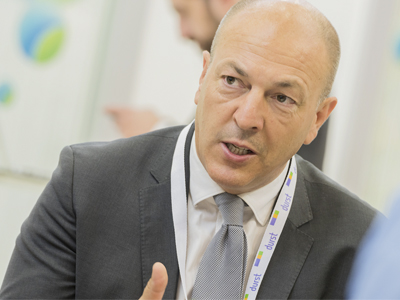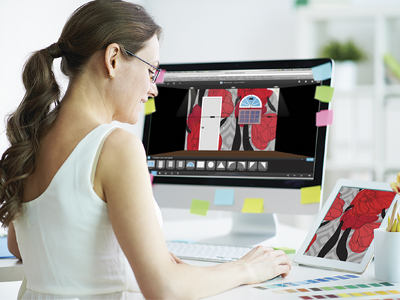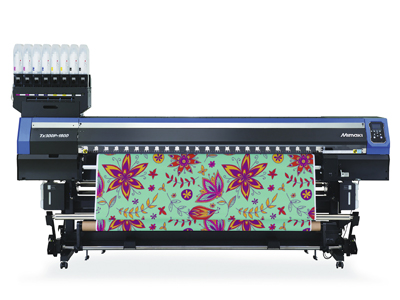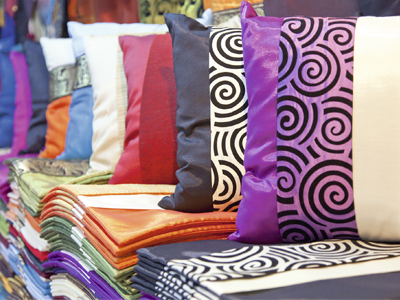The digitally-printed décor and furnishings market includes items such as these cushions , produced by Epson using its SureColor textile printers
There’s a growing market for digitally printed home furnishings and décor, but how easy is it to get into this market? Nessan Cleary draws back the curtain.
If you want to get an idea of the scope for digital décor printing, then just take a look around your home. Everything from wallpaper to curtains, cushions and even duvet covers represents a potential opportunity. For now, it’s a relatively small market, mainly driven by business sales opportunities. This includes things such as decorating a reception area with corporate logos on curtains and sofa covers, applying individual décor to each room in a hotel, or brightening up the children’s wards in a hospital.
Brett Platt, textile product manager for Hybrid Services, says that the market is very varied and ranges from people selling homeware and garments to the high street through to those printing fabric by the metre. He adds, ‘A lot of companies are starting to print to order to reduce stocking levels.’
Martin Winkeler, segment manager for Durst’s textiles division, says that for now one of the major drivers is the freedom of design, noting that with conventional rotary equipment the design has to be repeated ‘but you can digitally print photo images so this gives designers more freedom’. He points out that this can be combined with new business models, such as web-to-print for personalised online sales.

Martin Winkeler, segment manager for Durst’s textiles division
There is a strong expectation that this market is set for rapid growth. Mr Winkeler says that it depends on the geographic area, noting that worldwide growth for printed décor and furnishings is predicted to be 3.5% annually but that Europe is expected to see 25% growth over the next year.
Chris Davies, Epson’s product manager for large format textiles, says that the nature of the market is quite varied across Europe, noting, ‘A lot depends on the size of the customers. We are tending to see a lot more smaller producers in the UK because they can ship it overnight.’ He says that this includes mainly personalised and short-run products such as cushions but also window blinds and wall coverings.
Up against the wall
Perhaps the most obvious area for most wide-format users to start with is wallpapers and wall coverings. Any wide-format service provider should be able to produce wall coverings with their existing equipment and several vendors, including Epson and HP, have actively targeted this market. There’s a choice of substrates, such as canvas and textiles available for both solvent and latex printers, as well as for UV-curing models.
HP offers software and advice to its customers through a dedicated website – hpwallart.com – which service providers can use to develop a bespoke wallpaper business. The software can be set up to allow end customers to select the patterns and colours they want and to measure their own rooms to order exactly the right amount of wallpaper. There’s a reasonable choice of papers, including pre-pasted, which is similar to conventional wallpapers and just has to be submerged in water to activate the glue.

HP’s Wallart website includes tools to help customer design spaces and order the correct amount of digitally printed wallpaper
The next step up is dye sublimation, which relies on a heat press that effectively turns the printed image into a gaseous state, driving the pigments into the fibres of the fabric. It’s an extremely effective process that preserves the feel and texture of the substrate with the graphic able to survive multiple washes. There are two variations. The simplest is to print to a transfer paper, which can then be put through a heat press or calender along with the textile to transfer the image. The other option is to print direct to the textile. Some of these machines also have a built-in infra-red heater to fix the image. This is quicker but requires coated textiles. Most people will probably opt for the transfer paper, which will preserve the texture of the fabric and offer a wider choice of materials.
Most wide-format vendors produce dye sublimation printers up to 1.6m wide so there’s a good choice of equipment and inks at a relatively low cost. Mr Davies says that they offer enough productivity for most users, adding, ‘I think that the smaller producers will be able to hold their own because people always want more personalised work.’
Epson, for example, has three F-series SureColor dye sublimation printers. Two are 1.6m in width, offering up to 97 sqm/hr and there’s a 1.1m wide 63.4 sqm/hr model. All three use Epson’s UltraChrome DS ink with a choice between the HDK Black ink, which produces deep, neutral blacks for textile printing, and the standard black that’s better suited to promotional items. It should be pointed out that Roland, Mutoh and Mimaki all produce broadly similar dye sublimation printers of their own.
Cut from a different cloth
The main limitation of dye sublimation is that it only works with polyester materials, though this can include blended polyester fabrics. Mr Platt says that most people prefer polyester, which can look like cotton or linen, because of the cost, pointing out that ‘Polyester can be just as good and just as durable.’
Nonetheless, some materials require other types of inks. Disperse inks are used to print directly to polyester and polyester blends, while pigment inks are used for cotton and cotton blends as well as for polyester. Reactive inks are used for cotton, polyamide and silk, and acid-based inks are needed for wool, leather, silk and nylon. The main thing to note is that all of these inks will require different types of pre- and post-treatment.
Most vendors offer a choice of inks but you’ll have to use one for the life of the printer. However, Mimaki updated its TX300P textile printer earlier this year so that it can now be loaded with both pigment and sublimation inks at the same time. It’s designed to print direct to fabrics so this makes for a much more flexible solution that is able to handle a broad range of different materials in a single machine. The TX300 is a 1.8m wide printer with a maximum resolution of 1440dpi. It can print up to 68 sqm/hr. There’s also a ‘B’ version that has a sticky belt to handle stretchable or thin materials but is slightly slower at 50 sqm/hr.

Mimaki has updated its Tx300P textile printers to run two different inksets
The original machine could be loaded with one set of textile inks, with a choice including reactive and acid. But the pigment and sublimation inks both require a heat press for post-processing so loading these two ink types gives the broadest range of material handling without incurring additional finishing costs. The TP400 textile pigment ink is suitable for use with cotton and hemp materials for interior décor, tee shirts and other garments. It’s made up of solvent, pigment and binder agent. The Sb40 Sublimation dye ink is meant for use with pre-treated polyesters. Neither of these ink types requires any further washing or steaming other than the calender to fix the colours.
Bought by the yard
So far we’ve only considered smaller, more personalised pieces, but the other end of the market is about volume. Mr Winkeler says that home textile is better served by wider machines, up to 3.2m in width, but notes that this means that you also need the necessary steaming and washing equipment to cope with this width.
The bigger machines also come with a wider choice of inks. Mr Winkeler says that the application will dictate the type of ink, explaining, ‘For example in home textiles like curtains they are exposed to light so pigments are more useful than reactives, but for bedlinen then you need reactive ink.’
The reactive inks can give a softer feel but the fabric needs to be pre-treated and then steamed and washed, which takes time, as well as energy and a lot of water. Another issue is that you can only judge the colours after the process has been completed.
Durst has developed a new pigment ink called Greentex. Mr Winkeler says that it’s soft to the touch like a reactive ink, adding, ‘The colour yield is the same as reactive and the light-fastness is higher than any dye-sub.’
Durst has developed a number of textile printers for signage but its main model for the fashion and home furnishings sector is the Alpha, which is available in both a 3.3m and a 1.9m version. The Alpha is a single-pass inkjet machine designed to compete directly against screen printing. There’s a choice of inks, including reactive and sublimation as well as Greentex, with up to eight colours. The feed system adapts automatically to different textiles and roll diameters. Durst has also developed a Textile Workflow System that includes one-step profiling for new materials and colour matching.
Naturally, other vendors are also developing industrial textile printers. Konica Minolta, for example, has developed the SP-1, which can offer up to eight colours with a maximum print speed of 6400 sqm/hr. There’s a choice between reactive and disperse inks. The Italian company Reggiani, which is owned by EFI, has created the Renoir series of 3.4m wide inkjet printers, available with a choice of different inksets and pre and post-treatments.
The major difficulty in handling textiles is the degree of treatment, particularly the steaming and washing stages, that are needed for most applications to retain the feel of the fabric. This is less important for some applications, such as curtains and carpets and dye sublimation is good enough for personalised products like cushions and sofa coverings. The high volume end of the market is only just getting started, as new inks are being developed to help automate the post-processing. Nonetheless, many vendors expect this to be the next big thing in digital printing.
Read the full June/July issue here





